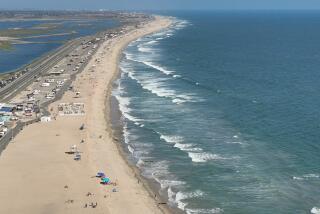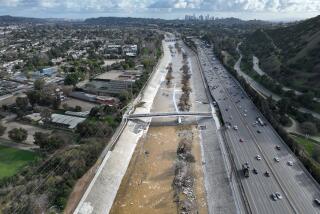Sandbagging : A Guide To Protecting Your House
The rains have dumped 5.17 inches on Downtown Los Angeles show no sign of letting up. Already the downpour has caused flooding and mudslides. With showers expected to continue, residents should know that they can take temporary emergency measures to protect their homes from further floods or mudslides.
Filling and Stacking the Bags The most efficient way of filling and stacking sandbags, which are made of either burlap or nylon, is shown below: *
Fill halfway: Overfilling makes the bags heavy and difficult to manage. *
Placement: Place with the flap tied or tucked under and pointed in the direction of the water or mud’s flow. *
Stacking: Place bags on top of each other tightly, with each layer staggered. Rows should be no more than three layers, unless supported by a building or stacked in a pyramid. *
Placing the Bags to Protect Building Use layers: Layers of bags should be placed against building. *
Protecting doors: To prevent water and mud from seeping under a sliding glass door, a plastic sheet should be placed against glass with sandbags or a plywood barrier holding the plastic in place. *
Directing Debris Away From Building Make a line: Layers of bags should be lined up away from house to divert flow of debris. *
Keep it in the street: Often curbs cannot contain floodwaters. Bags can be lined along the street to help contain the flow. *
Where to Get Sandbags Both the city and county fire departments are providing empty sandbags. Residents must fill the bags themselves. *
City Fire Department Some stations are providing a maximum of 25 bags per person or family. An unlimited number can be obtained if a resident has a sandbagging plot plan written by a Flood Control District engineer. *
County Fire Department Some county stations fare providing an unlimited number of bags. For the nearest station call community relations at (213) 881-2411. *
Where to Get Sand Gravel or garden supply stores. If sand isn’t readily available, bags can be filled with dirt, mud or rocks. *
Bags stacked in a pyramid, with closed end facing into the flow. *
Rain falling on hills bare of vegetation creates a flood danger. *
Cut slope drain to direct and slow flow of water. *
Plant slopes near home to absorb water and mud. *
Use a permanent brick wall to divert debris from home. *
Allow large path for flow of debris. *
Place layers of sandbags against building. *
Board up doors and windows to keep out debris. *
Erect temporary wooden fence to deflect debris from home. *
Sliding glass doors protected by plastic sheet. Sources: Los Angeles city and county fire departments; Researched and written by JULIE SHEER / Los Angeles Times
More to Read
Sign up for Essential California
The most important California stories and recommendations in your inbox every morning.
You may occasionally receive promotional content from the Los Angeles Times.










